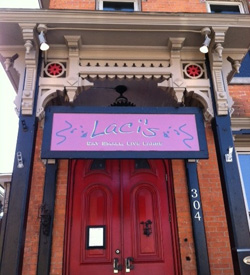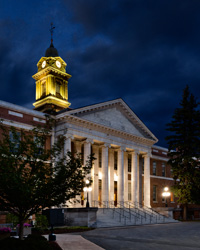informavore.com/testing/nylcweb/project/county/onondaga/
informavore.com/testing/nylcweb/maps/
At least eight local congregations will participate Saturday, May 21, and Sunday, May 22, in the New York Landmarks Conservancy’s statewide Annual Sacred Sites Open House Weekend. The Preservation Association of Central New York (PACNY) is once again co-sponsoring the event, which celebrates the 30th anniversary of the Sacred Sites Program.

The annual Open House Weekend has three main objectives:
* To encourage sacred sites to open their doors to the general public. Inviting visitors is a great way to build broad community support for the ongoing preservation of historic institutions.
* To inspire residents to be tourists in their own town, introducing non-members to the history, art and architecture embodied in sacred places.
* To publicize the many programs and services religious institutions offer their neighbors.
This event is an opportunity for the community to learn about the historic and cultural significance of these landmark buildings and experience the beauty of some of Syracuse’s hidden architectural treasures. Below are details about the Syracuse congregations that are participating. Click here to see a list of participants.
AME Zion Church (formerly People’s AME Zion)
711 East Fayette Street, Syracuse
Sunday, May 22, 2-4 p.m.
The church is undergoing substantial renovations, but will be available to visitors on Sunday 2-4 p.m., for a construction groundbreaking. There will be music and outdoor presentations honoring the past and sharing future plans for the former church.
Peoples A.M.E. Zion is the oldest African-American congregation in Syracuse and Central New York. Established in 1841, the congregation purchased its first building on South Crouse Street in 1848. In 1863 they replaced this church with a new, larger building, but by 1910 they had outgrown their facility once again, and planned a move to a new facility at 711 East Fayette Street, the site of this May’s groundbreaking and commemoration. By 1975, the congregation moved again, to its fourth and present location on South Salina Street. The 1910 church eventually fell into disrepair.
Designed by prominent Syracuse architect Charles Colton, the 1910 design and construction of the former People’s AME Zion church building at 711 East Fayette melds traditional late nineteenth- century Romanesque and Gothic revival styles with exposed turn-of-the-century structural components. The squat building with corner tower was a popular church design of the period. The design also employed contemporary features such as white Litholite (an artificial cast stone product) instead of natural stone, sand lime brick instead of hard fired brick, open structural steel trusses instead of traditional wooden sanctuary roof construction, and twentieth century leaded glass windows. Windows are leaded colored art glass panels representative of early twentieth century mass-produced catalog design motifs.
It is the oldest African-American church structure still standing in the city of Syracuse. Reflecting its history as an anchor of Syracuse’s African-American community and a center of civil rights activism, the church at 711 E. Fayette Street is listed on the National Register of Historic Places.
Church of the Saviour (Anglo-Catholic)
437 James Street, Syracuse
Saturday, May 21, 10 a.m.-3 p.m.
* Tours of the building, as well as displays of liturgical vestments, church history and the Anglo-Catholic tradition.
* Organ presentation by James Lawrence at 1 p.m. on the 1963 Möller Pipe Organ. Complimentary refreshments following organ presentation.
Sunday, May 22, 10 a.m.-2 p.m.
* Tours, except during Solemn High Mass (11:15 a.m.-12:30 p.m.).
The parish was organized in 1848, the same year the city of Syracuse was founded. At a time when most churches required parishioners to pay “rent” for their seats in church, it was formed as the first “freely seated and freely supported” parish in the Episcopal Diocese of Western New York and only the second in the state. Since its inception, it has held to many of the tenets of the Anglo-Catholic or “High Church” movement, which combined the beauty of music and traditional liturgy with a strong commitment to social justice.
In the 1920s, Saviour provided the Armenian immigrant community with a place to worship, and in recent years has welcomed an influx of Burmese refugees. The parish continues today as an inclusive and welcoming community.
The current church building was designed in 1891 in the Gothic style by the Syracuse architect Asa L. Merrick. After fire destroyed the interior in 1912, it was rebuilt under the direction of Dr. Ralph Adams Cram, who is remembered as the foremost American authority on Gothic architecture in the twentieth century. He is best known for his redesign of the Cathedral of St. John the Divine in New York City.
First English Lutheran Church
501 James Street, Syracuse
Saturday, May 21, 10:30 a.m.-3 p.m.
* During their tour, visitors will learn about the church’s history and architecture.
* Organ presentation at noon by Elaine Smith.
Although the Syracuse Downtown Committee draws the downtown line on the other side of Townsend Street, we think of ourselves as the downtown church. When we moved to the corner of James and N. Townsend in 1910, it was like moving from the city to the suburbs. Now, we’re in the city for good. We began in 1879, meeting in homes, the old court house, and eventually in a church building we bought from another congregation on the site of today’s Galleries on South Salina Street. When we dedicated this building, designed by Archimedes Russell, in 1911, we were debt free. We still are. Our beautiful stained glass windows were designed and constructed by Haskins.
Our M.P. Moeller organ was installed in 1924 and has 28 ranks. The new keyboard was added in 1976. It has three manuals. The swell division is nested above the choir loft while the great, choir and pedal divisions are high above the altar.
First English is on the National Register of Historic Places and received grants from the Sacred Sites program for major building restorations in the 1990s.
Grace Episcopal Church
412 University Avenue (corner Madison Street), Syracuse
Saturday, May 21, 10 a.m.-3 p.m. and Sunday, May 22, 11 a.m.-2 p.m.
* Visitors are welcome to visit the 1876 sanctuary and the recently renovated 1916 parish house.
* Parking available in lot off Madison Street.
Grace Episcopal Church was organized on March 27, 1871, and the current National Register-listed Gothic Revival building of Onondaga limestone was built in 1876 according to the design of architect Horatio Nelson White (Syracuse University Hall of Languages, Gridley Building). The tower, originally twice its existing height and considered Norman in style, was shortened in 1940 due to bulging of the upper walls. The rebuilding was redesigned by noted local architect Melvin King (Hills Building, collaborator on the county courthouse and Niagara-Mohawk Building) to give the church a “modern English appearance” (Syracuse Herald-Journal). The adjoining Arts and Crafts-inspired Gothic-Revival parish house was built in 1916-17 according to the design of architect Justus Moak Scrafford, an Ecole des Beaux-Arts-trained professor at Syracuse University. Scrafford also designed St. Philip’s Episcopal Church on Almond Street, an African-American parish that was closed in 1957 and subsequently lost to urban renewal. Many of the parishioners joined Grace, forming the diverse congregation that exists today. The parish recently completed a major rehabilitation of the parish house following a September 2013 kitchen fire. Plans are underway to repair the failing walls of the church tower and the pebble-dash stucco of the parish house.
Grace Church has a long history of social activism. In 1878, the church baptized and later ordained David Pendleton Oakerhater, a Cheyenne warrior and political prisoner who devoted his life to serving his people and the Episcopal Church. In 1992, Oakerhater was elevated to sainthood within the Episcopal Church—the first Native American saint in the church—and Grace was dedicated as his national shrine. In the 1960s, following the welcoming of African-American parishioners from St. Philips, Grace led the city’s churches in its commitment to civil rights.
Park Central Presbyterian Church
504 East Fayette Street, Syracuse
Sunday, May 22, 1-3 p.m.
* Organ Demonstration, Refreshments/Food Tastings, and Scheduled Guided Tours
The church will offer two guided tours of the historic 1875 Gothic Revival sanctuary (designed by Archimedes Russell) along with a pipe organ demonstration, at 1:15 p.m. and 2:15 p.m. Light snacks will be served. The pipe organ, completed in 1967 by the M.P. Moller company as a gift from former Syracuse mayor Anthony Henninger and his wife, Susan, in memory of their son, Robert, will be demonstrated by Professor Will Headlee. Highlights of the tour include beautiful stained glass windows from the Willet Studio in Philadelphia.
Park Church was established in 1846. Their first services were held at Market Hall, a building that stood on the site of the present City Hall. A new, Greek Revival church was built at the west end of Fayette Park (now Fayette Firefighters’ Memorial Park) in 1847. It was replaced by the present, Gothic Revival church, of red brick with sandstone trim, located at the opposite end of the park, designed by prolific Syracuse architect Archimedes Russell in 1872 and completed by 1875. Russell founded of the architectural school at Syracuse University. The church features two towers of uneven height flanking a central gable with a rose window.
The parish house wing was added in 1926. A west porch was added and the interior was given a makeover and extended balcony in 1967, all designed by Sargent Webster Crenshaw and Foley of Syracuse.
St Paul’s Episcopal Church (formerly Cathedral)
220 East Fayette Street, Syracuse
Saturday, May 21, 10 a.m.-3 p.m.; Sunday, May 22, noon to 3 p.m.
* Visitors are welcome to tour the historic Gothic Revival 1885 sanctuary.
* Plant sale and water.
St. Paul’s Church was founded in 1826; its first building dedicated in 1827, and has been located in three different buildings, all in downtown Syracuse near City Hall. The present church was built as the Cathedral Church for the Episcopal Diocese of Central New York, and from 1885 to 1897, again from 1972 to 2015, it was St. Paul’s Cathedral. The designer was English-born Henry Dudley, who drew up plans for a grand church in the style of English Gothic Revival, in turn influenced by American style. The building is made of Onondaga limestone and has changed very little on the outside, and only a bit more on the inside. The most remarkable feature is probably the great spire that rises over 200 feet and is topped by a seven-foot cross. Noteworthy are the stained-glass windows, most of which came from Cox, Buckley and Co. (London-New York). One window is from the Tiffany Studios (1895), another from Henry Keck (1925). There is seating for about 550. The nave is separated from the side aisles by arches supported by pillars of polished Nova Scotia granite. The walls are of yellow brick, broken by lines of decorated terra cotta tiles; this design is thought to be unique to St. Paul’s. All of the woodwork is Southern (hard) pine. Music plays an important role in the parish, and the 1967 church organ from Moeller was considered an appropriate choice for a large church. In 2001 the organ was rebuilt by Quimby Pipe Organs.
The congregation considers itself welcoming and inclusive. Sundays include an early quiet, meditative service, and a mid-morning Eucharist with a full choir. Each month the second service on the first Sunday is a Jazz Mass. St. Paul’s is also home to a South Sudanese congregation Symphoria performs its Casual Concerts here, and several other musical organizations perform in the church.
Temple Concord
910 Madison Street, Syracuse
Sunday, May 22, 9a.m.-noon
Tours of the building focusing on the sanctuary (101 years old and on the National Register of Historic Places), with docents giving the history of the facility, the congregation and the Jewish community in Syracuse.
Parking available in the lot on Madison Street and can either enter there (where there is an elevator) or walk around to University Avenue to walk up stairs and enter directly into the sanctuary.
Founded by German Jews in 1839 as the Society of Concord, and recognized as the ninth oldest continuously operating Jewish congregation in the United States, Temple Concord grew and prospered through the 19th century. Seizing the opportunity to acquire the present site at the corner of University and Madison, the congregation’s leaders engaged the renowned synagogue architect, Arnold W. Brunner, who along with Alfred Taylor, designed the classical sanctuary that celebrated its 100th anniversary in 2011, and is recognized by the National Register of Historic Places. A thriving 21st century congregation is proud to call the classical style sanctuary home and recently added lighting, banners, and landscaping to make the building a highlight of Syracuse University’s Connective Corridor.
University United Methodist Church
1085 East Genesee Street, Syracuse
Saturday, May 22, 10 a.m.-3 p.m. and Sunday, May 23, 12:30-2:30 p.m.
Church is on the corner of University Ave and East Genesee Street. Parking avilable at 324 University Ave., opposite the church. Tours of the building will be available at the above times.
In February 1914 a fire destroyed the older part of the church and seriously damaged the new part leaving, “only four walls where [the] once big church stood.” Professor Frederick W. Reveals, head of the Syracuse University Department of Architecture, and Professor Fred Lear, who studied with Reveals, drew the plans for the new church. While the style is not true Gothic, these architects mimicked the style as best they could while incorporating the remaining parts of the building.
Our magnificent stained glass windows extend almost floor to ceiling in our beautiful neo-Gothic sanctuary. In the tradition of the Middle Ages, the story of the life of Jesus Christ is portrayed in the windows. Starting in the left rear corner, the eight enormous windows show the birth of Christ, significant points in his ministry, his betrayal and resurrection. Each window includes the appropriate passage from Scripture. The ninth window is the Ascension window. It is visible only from the outside, above the front entrance, and is back lit at night. It presents Christ on the throne with the symbols of spiritual power.
Our music program is known for the excellence of the choir and the organ. The organ was built by Casavant Freres of St. Hyacinth, Quebec, and installed in 1970. It includes 3 manuals and nearly 3,000 pipes! Forty-five ranks of pipes are exposed, creating a contemporary display among the Gothic features of the sanctuary. Our Senior Choir typically consists of 25 to 30 voices and sings in 4 parts, accompanied by organ or piano. We also have a “no fault” orchestra and a Handbell Choir.






